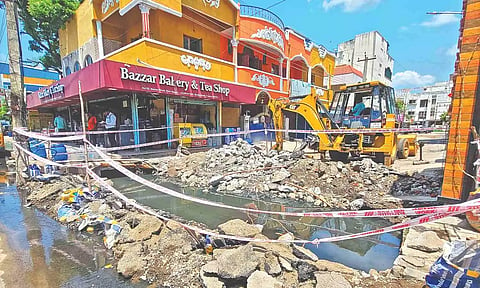

CHENNAI: Chennaites are not new to overflowing manholes and sewage stagnation during the monsoon season. However, for over a year, the challenge of navigating the city has compounded with the construction of both storm water drains (SWDs) and Metro Rail.
Though the northeast monsoon is yet to commence, the city has been experiencing intermittent spells which has led to clogged drains and reverse flow of drainage.
Just a few hours of rain inundated most neighbourhoods, leading to overflowing sewage and making it difficult for commuters and pedestrians, especially in low-lying areas. And the stench is unbearable, and sometimes, lasts for days.
“The issue of overflowing sewage has been persisting for a while. Garbage dumped by residents in the locality clogs the drain often,” said Dinesh (name changed), a resident of Old Washermenpet.
The drainage system was not desilted for a long time, which often leads to stagnation at Sanjeevarayanpet. “We used to take long routes to reach the main road due to the sewage overflow. After many complaints, civic authorities took over the underground maintenance work, which has been going on for over a month,” he added.
In many areas, residents tried to remove the clogged drains themselves but in vain. Whenever a complaint was raised to Metro Water officials, they would pump out the stagnated sewage but this was temporary, as residents rued the condition of recently-laid interior roads that were damaged due to the repeated problem of stagnation.
Similarly, residents of Rajabhathar Street at Perambur lamented that the board had not yet replaced the sewage pipeline which leads to overflowing.
“The street is always flooded with sewage water, as the concerned department has not replaced the pipes. And, garbage from the nearby government school clogs the sewage pipes which is the main reason for the overflow,” stated a resident.
During the monsoon season, there’s knee-deep water in several areas. But that’s not the only challenge. The civic body opens manholes to let stagnated water in. Sometimes, sewage overflows from these open manholes due to blockage in the drainage system. This worsens the situation and people are forced to walk on the filthy water and live with the stench.
Additionally, if the stagnated water is not drained in 3-4 days, it becomes a breeding ground for mosquitoes.
Occupants of residential and commercial buildings illegally discharge sewage into the canals that flow into Puzhal Lake, which is an important source of drinking water to a larger part of the city.
Since a sewage connection is expensive, residents often discharge untreated drainage into the lake and SWDs in the area.
“At least 60 lakh people in the city get their drinking water supply from the Puzhal reservoir. The drainage from hotels and residential areas are allowed to flow into the SWDs. This affects the quality of drinking water in many areas such as Banu Nagar, Tirumullaivoyal and Oragadam, as there is no proper underground sewage network,” said S Jayachandran, a resident of Korattur.
Residents and civic activists urge authorities to rejuvenate the waterbody, monitor the activity of the public, and impose fine against those who pollute the lake and drains.
A senior official of the Chennai Metropolitan Water Supply and Sewerage Board (CMWSSB) said that 1.32 lakh manholes were desilted, and added: “Work is going on in areas that have designated bus routes. And, routine maintenance works have been carried out across the city. The works are expected to be completed soon.”
The official admitted that residents let sewage into the SWDs which should be monitored by the Chennai Corporation. “When we get complaints from them, we address them immediately. The extended areas under the Chennai Corporation have septic tanks and the sewer is cleaned regularly. Ahead of the monsoon, we have sufficient equipment to ensure no sewage stagnation is experienced,” added the official.
The number of complaints related to sewage overflow and stagnation has not increased even with intermittent rain in the city.
The Greater Chennai Corporation (GCC) has urged the authorities to complete the interlinking of SWDs quickly, as the pace of work has been very slow.
Residents in flood-prone areas fear a repeat of the deluge in 2021. They’re concerned that the incomplete drain works would lead to slushy roads during the monsoon.
“The civic body is supposed to have completed the interlinking work at Lake View Road in Madipakkam by now. Because it hasn’t, there would be overflow during the monsoon and mosquito menace too. And there is no point in constructing SWDs without the linking work,” stated S Seetharaman, a resident and civic activist of Madipakkam.
Though senior officials had prohibited any new digging of roads for underground maintenance work, the civic body began the new SWD work in Kolathur. And, the interlinking work remains incomplete.
Residents pointed out that officials should have given approval to begin the construction work after they had completed the interlinking in the area. “This is leading to traffic congestion. And, the recent intermittent spells have turned the road muddy and slippery. It’s unsafe for commuters and pedestrians,” stated a resident.
Similarly, SWD work that began two weeks ago at Ekkattuthangal is still going on. Contractors have placed only two barricades in the area. “Civic authorities do not follow safety guidelines while constructing SWDs. Almost half the road is occupied. Since it’s adjacent to the Metro station, it’s always congested. There is not enough space for pedestrians.
ities should halt construction work until the monsoon stops to prevent mishaps,” rued R Ramesh, a motorist.
A senior corporation official said that almost 80% of the interlinking work of SWDs has been completed in the city. “Even during recent rains, most areas did not witness water stagnation and all subways were open for traffic. And if there is any water-logging in low-lying areas, it’s pumped out immediately. Most of the work will be completed before the onset of the northeast monsoon. Else, it would resume from January,” he explained.